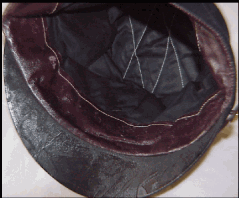|
click on an image to enlarge    |
McDowell Pattern Cap Belonging to Vermont Quartermaster General George Franklin Davis (1857 - 1864)
This piece is from our personal collection and exhibits the typical construction of the U.S. Army pattern 1858, also known as the "McDowell" pattern forage cap. This cap is made of dark blue wool broadcloth as were most of this pattern. The cap measures 4.5" tall in front and 7" tall in rear.
You will see the inside lining of the cap which is made of black cotton. There is slight padding in the top which is held by two lines of white machine stitching in opposite V shapes, forming an elongated diamond of overlapping V’s. The sweatband which you see is made of a maroon or dark purple morocco leather, with a tooled designed of parallel lines over the surface. There is a decorative machine stitching in white around the loose edge.
The visor and chinstrap are of black patent leather. The chinstrap is 5/8" wide, in two pieces, held at one end by a loop and the other by a brass slide. The side buttons are small stag head Vermont state seals, with tin backs and backmarked: "D.Evans & Co* Extra." D. Evans buttons were very predominate during the Civil War. The visor is a single piece of leather, 3/32" thick, and 1.75" deep at the center front, sloping to the ends. There is a tooled line with a parallel dotted line on the edge.
Sewed to the front of the cap is a dark blue velvet oval patch, 2" x 2.5", with a gold embroidered wreath and "VVM" (Vermont Volunteer Militia) in silver braid and old English script.
Brief History of General Davis
Davis was elected Quartermaster-General State of Vermont, in 1857, with the rank of Brigadier-General, filling the office for seven years, during which time the War of the Rebellion broke out. General Davis equipped and sent into the field the First thru Seventeenth Vermont Volunteer Infantry regiments.
It is a matter of record that the troops from no other State were sent into the field better armed and equipped or in better condition in every way than those from the Green Mountain State. During his administration, General Davis frequently went to the front to look after and care for the sick and wounded, and to do anything in his power for their comfort.
Below is an excerpt from a letter Davis wrote to his wife Ada dated April 25, 1862
Saturday General Mansfield furnished me with a horse and saddle, haversack with three days’ rations and a Dragoon to pilot me to the Grand Army near Yorktown, the distance was twenty miles. Major Proctor went with me. The roads are awful. The roads cut through heavy timber lands apart of the way, mud knee deep, and less than a part of the way corduroy or timber road made of poles laid across the road - miles of it is made in this way. Saturday night we slept in Rebel barracks at Young’s Mills. Sunday morning took an early start and found our Brigade about nine o’clock encamped in heavy pin timber within one mile and a half of the Rebel fortifications where there was constant firing by the pickets and sharpshooters, also cannoning. Occasionally a shot or shell would go over us and make quite a buzzing....
......there was thirty-seven (of our troops) sent to the Hygria Hotel Hospital, Fortress Monroe on Monday. All that could be sent that day. The poor fellows are shot in almost every place you can imagine. Some in the head, neck, arms, shoulders, hands, legs and feet, and one through the body that is still living.
I do so hope you enjoyed this article. Take care and thank you.
Best of Wishes,
The Civil War Antiques Preservation Society
|